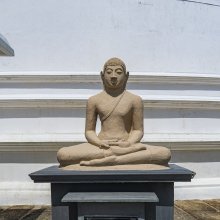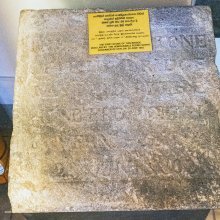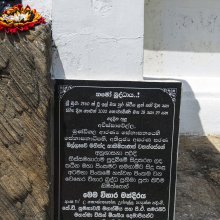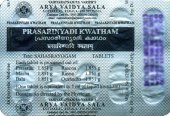Masha, Māsa, Masa, Māṣa, Maśa, Māsā, Ma-sha: 46 definitions
Introduction:
Masha means something in Buddhism, Pali, Hinduism, Sanskrit, Jainism, Prakrit, the history of ancient India, Marathi, Hindi, biology. If you want to know the exact meaning, history, etymology or English translation of this term then check out the descriptions on this page. Add your comment or reference to a book if you want to contribute to this summary article.
The Sanskrit terms Māṣa and Maśa can be transliterated into English as Masa or Masha, using the IAST transliteration scheme (?).
Alternative spellings of this word include Maas.
Images (photo gallery)
(+17 more images available)
In Hinduism
Ayurveda (science of life)
Dietetics and Culinary Art (such as household cooking)
Source: Shodhganga: Dietetics and culinary art in ancient and medieval IndiaMāṣa (माष) refers to “black-gram” and is listed as one of the varieties of pulses, according to the Vājasaneyisaṃhitā XVIII.12, and is commonly found in literature dealing with the topics of dietetics and culinary art, also known as Pākaśāstra or Pākakalā.—In Vedic literature, different varieties of pulses like māṣa (black-gram), mudga (green-gram) and masūra (lentils) were referred to. But it is interesting that for some reason māṣa is not considered edible as it is despised for sacrificial purposes. In Vālmīkirāmāyaṇa, pulses like māṣa (black-gram), mudga (green-gram), kulattha (horsegram) and caṇaka (hemp) are mentioned. [...] The medical works regard māṣa as the worst among all pulses because it is very difficult to digest.
Māṣa or “black gram” is mentioned as being harmful (ahita) to the body according to the 17th century Bhojanakutūhala in the dravyaguṇāguṇa-kathana, which contains the discussions on different food articles and their dietetic effects according to the prominent Ayurvedic treatises. Here In the śimbīdhānya (legumes) group māṣa (black-gram) is mentioned as harmful to the body (ahita).
Māṣa or “black-gram” is mutually incompatible (viruddhāhāra) with Ānūpamāmṣa (the meat of animals living in marshy lands).
Māṣa (‘urad dal’ or ‘black-gram’) is mentioned in a list of potential causes for indigestion.—A complete section in Bhojanakutūhala is devoted for the description of agents that cause indigestion [viz., māṣa (urud dal)]. These agents consumed on a large scale can cause indigestion for certain people. The remedies [viz., salila (water) or kitava (thorn apple)] for these types of indigestions are also explained therewith.
Māṣa (black gram) have many properties according to Ayurvedic treatises like it is very unctous, strengthening, alleviates bile, imparts taste etc. But Aṣṭāṅgahṛdaya states that it is most inferior grain and is very difficult to digest. Black-gram vaṭakas contains other constituents like ginger, asafoetida etc. which helps the digetion of black-gram in a proper manner.
The dishes described in Bhojanakutūhala in which black gram (māṣa) is a main ingredient are of three varieties:—
- parpaṭa,
- alīkamaccha,
- vaṭaka.
Cikitsa (natural therapy and treatment for medical conditions)
Source: Ancient Science of Life: Botanical identification of plants described in Mādhava CikitsāMāṣa (माष) refers to the medicinal plant Phaseolus mungo L., and is used in the treatment of atisāra (diarrhoea), according to the 7th century Mādhavacikitsā chapter 2. Atisāra refers to a condition where there are three or more loose or liquid stools (bowel movements) per day or more stool than normal. The second chapter of the Mādhavacikitsā explains several preparations [including Māṣa] through 60 Sanskrit verses about treating this problem.
Kalpa (Formulas, Drug prescriptions and other Medicinal preparations)
Source: Shodhganga: Edition translation and critical study of yogasarasamgraha1) Māṣa (माष) refers to a unit of measurement of weight (1 māṣa equals 1mg; 12 māṣas = 1 karṣa = 12g), as defined in the 15th-century Yogasārasaṅgraha (Yogasara-saṅgraha) by Vāsudeva: an unpublished Keralite work representing an Ayurvedic compendium of medicinal recipes. The Yogasārasaṃgraha [mentioning māṣa] deals with entire recipes in the route of administration, and thus deals with the knowledge of pharmacy (bhaiṣajya-kalpanā) which is a branch of pharmacology (dravyaguṇa).
A relative overview of weight-units is found below, māṣa indicated in bold. In case of liquids, the metric equivalents would be the corresponding litre and milliliters.
1 Ratti or Guñjā = 125mg,
8 Rattis - 1 Māṣa = 1g,
4 Māṣa - 1 Kaḻañc = 4g,
12 Māṣas - 1 Karṣa = 12g,
1 Karṣa /Akṣa - 1 Niṣka = 12g,
2 Karṣas - 1 Śukti = 24g,
2 Śukti - 1 Pala = 48g,
2 Palas - 1 Prasṛti = 96g,
2 Prasṛtis - 1 Kuḍava = 192g,
2 Kuḍava - 1 Mānikā = 384g,
2 Mānikās - 1 Prastha (Seru) = 768g,
4 Prasthas - 1 Āḍhaka (Kaṃsa) = 3.072kg,
4 Āḍhakas or Kalaśas - 1 Droṇa = 12.288kg,
2 Droṇas - 1 Surpa = 24.576kg,
2 Surpas - 1 Droṇī (Vahi) = 49.152kg,
4 Droṇīs - 1 Khari = 196.608kg,
1 Pala = 48g,
100 Palas - 1 Tulā = 4.8kg,
20 Tulās - 1 Bhāra = 96kg.
2) Māṣa (माष) refers to the medicinal plant known as “Vigna mungo (Linn.) Hepper” and is dealt with in the 15th-century Yogasārasaṅgraha (Yogasara-saṅgraha) by Vāsudeva: an unpublished Keralite work representing an Ayurvedic compendium of medicinal recipes. The Yogasārasaṃgraha [mentioning māṣa] deals with entire recipes in the route of administration, and thus deals with the knowledge of pharmacy (bhaiṣajya-kalpanā) which is a branch of pharmacology (dravyaguṇa).
Toxicology (Study and Treatment of poison)
Source: Shodhganga: Kasyapa Samhita—Text on Visha ChikitsaMāṣa (माष) or “black-gram” is the name of an ingredient used in the treatment of Rājilā-snake-bites, according to the Kāśyapa Saṃhitā: an ancient Sanskrit text from the Pāñcarātra tradition dealing with both Tantra and Viṣacikitsā—an important topic from Āyurveda which deals with the study of Toxicology (Viṣavidyā or Sarpavidyā).—The tenth Adhyāya prescribes antidotes for Rājilā snake venom.—According to the Kāśyapasaṃhitā verse X.13: “Lepa or ointment of Pippali and blackgram (māṣa) destroy Rājila viṣa found in the house. This combined with Śāribā and husk is potent to neutralise Kālodaraviṣa”.
Agriculture (Krishi) and Vrikshayurveda (study of Plant life)
Source: Shodhganga: Drumavichitrikarnam—Plant mutagenesis in ancient IndiaMāṣa (माष) [māṣaja] (identified with Vigna mungo) is used in various bio-organical recipes for plant mutagenesis such as changing plants into creepers, according to the Vṛkṣāyurveda by Sūrapāla (1000 CE): an encyclopedic work dealing with the study of trees and the principles of ancient Indian agriculture.—Accordingly, “Tamarindus indica is grown into an excellent creeper if fed with water, mixed with the powder of Embelica officinalis, Terminalia bellirica and Terminalia chebula, Sesamum indicum, Hordeum vulgare, and Vigna mungo [E.g., Māṣaja] and then smoked well with the Curcuma longa powder.
Unclassified Ayurveda definitions
Source: Wisdom Library: Āyurveda and botany1) Māṣa (माष) is a Sanskrit word referring to Vigna mungo (“black gram”). It is a type of legume (śamīdhānya), according to Caraka in his Carakasaṃhitā sūtrasthāna (chapter 27), a classical Ayurvedic work. The plant Māṣa is part of the Śamīdhānyavarga group of medicinal plants, referring to the “group of legumes”. Caraka defined such groups (vargas) based on the dietic value of the plant. Māṣa is aphrodisisac, excellent vāta-alleviating, unctuous, hot, weet, heavy and strength-promoting in character. It causes an abundance of faeces and gives sexual potency.
2) Māṣa (माष) is the Sanskrit name for a weight unit corresponding to ‘1 gram’ used in Ayurvedic literature, according to the Ṣoḍaśāṅgahṛdayam. A single Māṣa unit corresponds to 8 Raktikā units (a single Raktikā unit equals the weight of a Guñjā-seed, roughly 1/8th gram). You need a 10 Māṣa units to make a single Karṣa unit (1 Karṣa equals 10 grams).
Below follows a table of the different weight units in relation to one another and their corresponding values in brackets:
- Guñjā (Raktikā) = 1 seed of Guñjā
- 8 Raktikā = 1 Māṣa (1 gram)
- 10 Māṣa = 1 Karṣa (10 grams)
- 2 Karṣa = 1 Śukti (20 grams)
- 2 Śukti = 1 Pala (40 grams)
- 2 Pala = 1 Prasṛta (80 grams)
- 2 Prasṛta = 1 Kuḍava (Añjali) (160 grams)
- 2 Kuḍava = 1 Śarāva (320 grams)
- 2 Śarāva = 1 Prastha (640 grams)
- 4 Prastha = 1 Āḍhaka (Pātra) (2.56 kilograms)
- 4 Āḍhaka = 1 Droṇa (10.24 kilograms)
- 4 Droṇa = 1 Droṇī (40.96 kilograms)
- 100 Pala = 1 Tulā (4 kilograms).
1) Māsa (मास) refers to “months” and is mentioned in verse 3.1 of the Aṣṭāṅgahṛdayasaṃhitā (Sūtrasthāna) by Vāgbhaṭa.—Accordingly, “[...] Beginning with Mārgaśīrśa (and comprising) two (months [viz., māsa]) each, there are said to be six seasons in succession.”.
Note: Māsa (“month”) has been left untranslated; for the instrumental absolute see Whitney, Skt. Gr. § 281 g.
2) Māṣa (माष) refers to “products made of urd-beans”, which is mentioned in verse 3.12 of the Aṣṭāṅgahṛdayasaṃhitā (Sūtrasthāna) by Vāgbhaṭa.—Accordingly, “[...] Having thereupon bathed according to ritual—with the oil removed by an astringent—,rubbed (one’s body) with musk-charged saffron, (and) fumigated (oneself) with aloe-wood one shall (at last) turn to rich, broths, fat meat, rum, barm, arrack, delicious products made of wheat, (rice-)flour, urd-beans [viz., māṣa], sugarcane, and milk, [...]”.
Source: gurumukhi.ru: Ayurveda glossary of termsMāṣā (माषा):—A unit of Measurement; 5 / 7 / 10 abrus seeds are equal to one masha kidney bean = 1 g of metric units
Source: eJournal of Indian Medicine: Jajjaṭa’s Nirantarapadavyākhyā and Other Commentaries on the CarakasaṃhitāMāṣa (माष) refers to Phaseolus mungo Linn., and is a medicinal plant mentioned in the 7th-century Nirantarapadavyākhyā by Jejjaṭa (or Jajjaṭa): one of the earliest extant and, therefore, one of the most important commentaries on the Carakasaṃhitā.—(Cf. Glossary of Vegetable Drugs in Bṛhattrayī 308, Singh and Chunekar, 1999).—(Cf. Indian Medicinal Plants 5:367, Arya Vaidya Sala, 1993-96.).—Note: Phaseolus mungo L. is a synonym of Vigna mungo (L.) Hepper (PL).—(Cf. The Plant List, A Working List of All Plant Species 34, 461, Royal Botanic Gardens, Kew and Missouri Botanical Garden).

Āyurveda (आयुर्वेद, ayurveda) is a branch of Indian science dealing with medicine, herbalism, taxology, anatomy, surgery, alchemy and related topics. Traditional practice of Āyurveda in ancient India dates back to at least the first millenium BC. Literature is commonly written in Sanskrit using various poetic metres.
Purana and Itihasa (epic history)
Source: archive.org: Puranic Encyclopedia1) Māṣa (माष).—A measure of weight in ancient Bhārata. (See under Trasareṇu).
2) Māsa (मास).—(months)
2) . General information. It is believed that every where for a year there are twelve months. There are six different kinds of months in force in Bhārata. They are the following:—
Source: archive.org: Nilamata Purana: a cultural and literary studyMāṣa (माष) refers to Phaseolus radiatus, forming part of a common diet in ancient Kashmir (Kaśmīra) as mentioned in the Nīlamatapurāṇa.—The Nīlamata refers to the powder of Māṣa as an unguent (verse 422). Most of the references to the articles of diet occur in the Nīlamata in connection with the offerings made to the gods but it is not difficult to infer from them the food and drink of the common people because “what a man eats his gods eat”.
Source: archive.org: Shiva Purana - English Translation1) Māsa (मास) refers to “black gram”, which is given to the priest in the Prājāpatya ceremony, according to the Śivapurāṇa 2.1.14:—“[...] silver coins and black gram (māsa) shall be given as fee to the priest as much as for two Prājāpatya ceremonies. If the devotee cannot afford it he shall give according to his capacity”.
2) Māsa (मास) refers to a “month”, according to the Śivapurāṇa 2.3.35 (“The story of Padmā and Pippalāda”).—Accordingly, as Vasiṣṭha said to Himavat mount (Himācala): “[...] After a week there is a very auspicious hour very rare to meet with. The presiding planet of the lagna is in the lagna. The moon is in conjunction with his son, Mercury as well as the constellation Rohiṇī. The moon and the stars occupy pure positions. The month is Mārgaśīrṣa (mārga-māsa) and the day is Monday free from all defects. All the planets are in auspicious conjunction. They are not aspected by the evil planets. The Jupiter is in a position that is conducive to the birth of a good child and all good fortune to the bridegroom. [...]”.
Source: Cologne Digital Sanskrit Dictionaries: The Purana Index1a) Māṣa (माष).—A tribe;1 a kind of grain.2
1b) A small coin; fine of, for removing the rope, pot, etc., from a well;1 a weight.2
2) Māsa (मास).—30 days and nights; two pakṣas; two months equal to a ṛtu; six months constitute an ayaṇa and two ayaṇas make one year; the twelve names of months Tapa, Tapasya, etc. are mentioned.*
- * Brahmāṇḍa-purāṇa II. 7. 20; 13. 14 and 114; Vāyu-purāṇa 3. 14; 30. 16 and 178; 31. 26; Vāyu-purāṇa 65. 58; Viṣṇu-purāṇa I. 3. 9-10; II. 8. 81; VI. 3. 10.

The Purana (पुराण, purāṇas) refers to Sanskrit literature preserving ancient India’s vast cultural history, including historical legends, religious ceremonies, various arts and sciences. The eighteen mahapuranas total over 400,000 shlokas (metrical couplets) and date to at least several centuries BCE.
Jyotisha (astronomy and astrology)
Source: Wisdom Library: Brihat Samhita by Varahamihira1) Māsa (मास) refers to 1 (one) solar month, according to the Bṛhatsaṃhitā (chapter 2), an encyclopedic Sanskrit work written by Varāhamihira mainly focusing on the science of ancient Indian astronomy astronomy (Jyotiṣa).—Accordingly, “We shall now proceed to give a brief description of (the qualifications of) a jyotiṣaka. [...] He must have a correct, knowledge of a yuga (43,20,000 Solar years), varṣa (a solar year), āyana (6 solar months), ṛtu (2 solar months), māsa (a solar month), pakṣa (15 solar days), ahorātra (a solar day), yama (one-eighth of a solar day), muhūrta (one-thirtieth of a solar day), nāḍī (one-sixtieth of a solar day or 24 minutes), vināḍi (one sixtieth of a nāḍī or 24 seconds), prāṇa (4 seconds) truṭi (33, 75th of a second) and parts of a truṭi and other divisions of time and also of divisions of space”.
2) Māṣa (माष) refers to “black gram”, according to the Bṛhatsaṃhitā (chapter 16) (“On the planets—graha-bhaktiyoga”), an encyclopedic Sanskrit work written by Varāhamihira mainly focusing on the science of ancient Indian astronomy astronomy (Jyotiṣa).—Accordingly, “[...] Rāhu also presides over notorious sinners, fops, Rākṣasas, excessive sleepers, all sentient beings and wicked persons; over black gram (māṣa) and gingelly seed. [...]”.
Source: Wikibooks (hi): Sanskrit Technical TermsMāsa (मास).—Month. Note: Māsa is a Sanskrit technical term used in ancient Indian sciences such as Astronomy, Mathematics and Geometry.

Jyotisha (ज्योतिष, jyotiṣa or jyotish) refers to ‘astronomy’ or “Vedic astrology” and represents the fifth of the six Vedangas (additional sciences to be studied along with the Vedas). Jyotisha concerns itself with the study and prediction of the movements of celestial bodies, in order to calculate the auspicious time for rituals and ceremonies.
Pancaratra (worship of Nārāyaṇa)
Source: archive.org: Isvara Samhita Vol 5Māṣa (माष) refers to “black gram” and represents one of the seven village-corns that are fit for food-offerings according to verse 25.57 of the Īśvarasaṃhitā, dealing with the classification of the places for building the fire-pits (kuṇḍa). Accordingly, “rice (śāli), green gram (mudga), barley (yava), black gram (māṣa), wheat (godhūma), priyaṅgu (panic seed) and seasamum (tila)—these seven grown in the village are to be taken in the work of preparation of caru”.
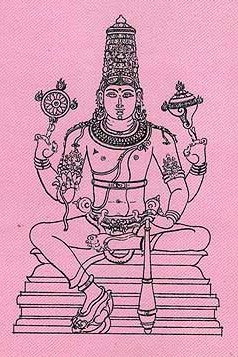
Pancaratra (पाञ्चरात्र, pāñcarātra) represents a tradition of Hinduism where Narayana is revered and worshipped. Closeley related to Vaishnavism, the Pancaratra literature includes various Agamas and tantras incorporating many Vaishnava philosophies.
Vaishnavism (Vaishava dharma)
Source: Pure Bhakti: Arcana-dipika - 3rd EditionMāsa (मास) refers to “month”.—There are twelve months in a Vedic lunar calendar, and approximately every three years, there is a thirteenth month. Each month has a predominating deity and approximately corresponds with the solar christian months:—
- Phālguna — Govinda (February-March);
- Caitra — Viṣṇu (March-April);
- Vaiśākha — Madhusūdana (April-May);
- Jyaiṣṭha — Trivikrama (May-June);
- Āṣāḍha — Vāmana (June-July);
- Śrāvaṇa — Śrīdhara (July-August);
- Bhādrapada — Hṛṣīkeśa (August-September);
- Āśvina — Padmanābha (September-October);
- Kārtika — Dāmodara (October-November);
- Mārgaśīrṣa — Keśava (November-December);
- Pauṣa — Nārāyaṇa (December-January);
- Māgha — Mādhava (January-Februray);
- Adhika — Puruṣottama (...-...);
In accordance with the month of the year, one would utter the Vedic month, for example, kārtika-māsi.
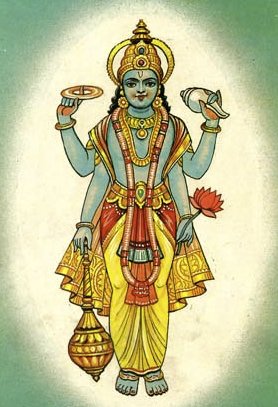
Vaishnava (वैष्णव, vaiṣṇava) or vaishnavism (vaiṣṇavism) represents a tradition of Hinduism worshipping Vishnu as the supreme Lord. Similar to the Shaktism and Shaivism traditions, Vaishnavism also developed as an individual movement, famous for its exposition of the dashavatara (‘ten avatars of Vishnu’).
Shaktism (Shakta philosophy)
Source: Google Books: ManthanabhairavatantramMāsā (मासा) refers to the “moon”, according to the Manthānabhairavatantra, a vast sprawling work that belongs to a corpus of Tantric texts concerned with the worship of the goddess Kubjikā.—Accordingly, “The plane of the One-footed (ekapāda i.e. the letter E) is where the Skyfarer is in the Skyfarer within the Cavity of the Hair. Śrīdeva is above Meru (the triangle above the head) (merupaścima) in the essential nature of the Void, which is the threefold measure (of energy). (This is) where everything consists of Space and is the Cavity (vivara), which is the nectar of Fire (vāḍava). There, above, in the Void is the supreme god. (He is) the moonbeam (candrāṃśu) that, well-fixed, oozes (nectar). The (energy of the) Full Moon (pūrṇa-māsā) resides as the teacher's being (gurutva) on the plane of the Skyfarer”.
Source: Addaiyan Journal of Arts, Humanities and Social Sciences: Tantra Literature of Kerala- Special Reference to MātṛsadbhāvaMāṣa (माष) or “urad dal” refers to one of various seeds used in Bījāṅkurārpaṇa, according to the Mātṛsadbhāva, one of the earliest Śākta Tantras from Kerala.—Mātṛsadbhāva is a Kerala Tantric ritual manual dealing with the worship of Goddess Bhadrakālī (also known as Rurujit) along with sapta-mātṛs or Seven mothers. [...] There are many descriptions about the flora and fauna in Mātṛssadbhāva. Different types of Seeds, dhātūs, metals, etc. are describing in this text. In the seventh chapter of Mātṛsadbhāva is describing the bījāṅkurārpaṇa part, tells seven types seeds need to be used [e.g., māṣa].

Shakta (शाक्त, śākta) or Shaktism (śāktism) represents a tradition of Hinduism where the Goddess (Devi) is revered and worshipped. Shakta literature includes a range of scriptures, including various Agamas and Tantras, although its roots may be traced back to the Vedas.
Shaivism (Shaiva philosophy)
Source: Brill: Śaivism and the Tantric TraditionsMāsa (मास) refers to “months”, according to the Kiraṇatantra chapter 49 (dealing with vratacaryā).—Accordingly, “Garuḍa spoke: ‘You have taught me, O great Lord, the activities of the Neophyte, the Putraka and the Ācārya. Tell me those of the Sādhaka’. The Lord spoke: ‘[...] This is the auspicious Raudra-vrata: imposing with a chignon of matted locks, marked by a trident and khaṭvāṅga, equipped with a clean half skull, awe-inspiring with a third eye, clothed in the skin of a tiger, peaceful. For one firm [in this observance, the highest Siddhi will arise in six months (ṣaṣ-māsa)]; middling [powers] in four months (catur-māsa); the lowest [powers] will arise in three months (tri-māsa). [...]’”.

Shaiva (शैव, śaiva) or Shaivism (śaivism) represents a tradition of Hinduism worshiping Shiva as the supreme being. Closely related to Shaktism, Shaiva literature includes a range of scriptures, including Tantras, while the root of this tradition may be traced back to the ancient Vedas.
Ganitashastra (Mathematics and Algebra)
Source: archive.org: Hindu MathematicsMāsa (मास) represents the number 12 (twelve) in the “word-numeral system” (bhūtasaṃkhyā), which was used in Sanskrit texts dealing with astronomy, mathematics, metrics, as well as in the dates of inscriptions and manuscripts in ancient Indian literature.—A system of expressing numbers by means of words arranged as in the place-value notation was developed and perfected in India in the early centuries of the Christian era. In this system the numerals [e.g., 12—māsa] are expressed by names of things, beings or concepts, which, naturally or in accordance with the teaching of the Śāstras, connote numbers.
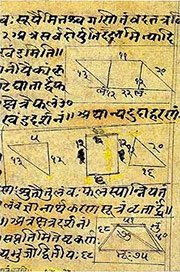
Ganitashastra (शिल्पशास्त्र, gaṇitaśāstra) refers to the ancient Indian science of mathematics, algebra, number theory, arithmetic, etc. Closely allied with astronomy, both were commonly taught and studied in universities, even since the 1st millennium BCE. Ganita-shastra also includes ritualistic math-books such as the Shulba-sutras.
Shilpashastra (iconography)
Source: Shodhganga: Elements of Art and Architecture in the Trtiyakhanda of the Visnudharmottarapurana (shilpa)Māṣa (माष) or “bean” refers to a particular shade of the green color, created through the principles of the ancient Indian tradition of Painting (citra), according to the Viṣṇudharmottarapurāṇa, an ancient Sanskrit text which (being encyclopedic in nature) deals with a variety of cultural topics such as arts, architecture, music, grammar and astronomy. In the Viṣṇudharmottarapurāṇa, five colours are regarded as the primary ones. A painter can create hundreds or thousands of colours by amalgamating the primary ones. Many shades of a particular colour also can be created by increasing or decreasing the quantity of the white part in the mixture. [...] The colour of nīlotpala i.e., the blue lotus and māṣa i.e., bean can be created when blue is amalgamated with light whitish yellow in more, less or in equal.
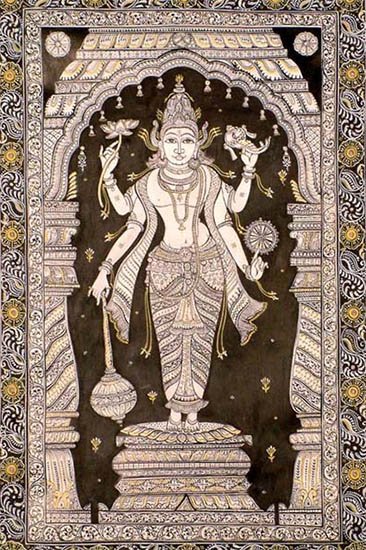
Shilpashastra (शिल्पशास्त्र, śilpaśāstra) represents the ancient Indian science (shastra) of creative arts (shilpa) such as sculpture, iconography and painting. Closely related to Vastushastra (architecture), they often share the same literature.
Yoga (school of philosophy)
Source: ORA: Amanaska (king of all yogas): A Critical Edition and Annotated Translation by Jason BirchMāsa (मास) refers to a “month”, according to the Amanaska Yoga treatise dealing with meditation, absorption, yogic powers and liberation.—Accordingly, as Īśvara says to Vāmadeva: “[...] [Now], I shall define the nature of that highest, mind-free absorption which arises for those devoted to constant practice. [...] Remaining in absorption for the [following] times; moments, breaths, Palas, Nāḍīs, Praharas, days, months (māsa) and years, [the Yogin] then goes to the highest reality. [...]”.

Yoga is originally considered a branch of Hindu philosophy (astika), but both ancient and modern Yoga combine the physical, mental and spiritual. Yoga teaches various physical techniques also known as āsanas (postures), used for various purposes (eg., meditation, contemplation, relaxation).
In Buddhism
Tibetan Buddhism (Vajrayana or tantric Buddhism)
Source: OSU Press: Cakrasamvara SamadhiMāsa (मास) refers to a “lunar month” [i.e., māse amuka], according to the Guru Mandala Worship (maṇḍalārcana) ritual often performed in combination with the Cakrasaṃvara Samādhi, which refers to the primary pūjā and sādhanā practice of Newah Mahāyāna-Vajrayāna Buddhists in Nepal.

Tibetan Buddhism includes schools such as Nyingma, Kadampa, Kagyu and Gelug. Their primary canon of literature is divided in two broad categories: The Kangyur, which consists of Buddha’s words, and the Tengyur, which includes commentaries from various sources. Esotericism and tantra techniques (vajrayāna) are collected indepently.
General definition (in Buddhism)
Source: Wisdom Library: BuddhismMāsa (मास)—One of the field-crops mentioned in the Jātakas.
In Jainism
General definition (in Jainism)
Source: archive.org: Jaina YogaMāṣa (माष) refers to a type of pulse (Phaseolus radiatus) and represents one of the seventeen varieties of dhānya (“grain”) according to Śvetāmbara tradition and listed in Hemacandra’s 12th century Yogaśāstra (verse 3.95). Dhānya represents one of the classes of the external (bahya) division of attachment (parigraha) and is related to the Aparigraha-vrata (vow of non-attachment).

Jainism is an Indian religion of Dharma whose doctrine revolves around harmlessness (ahimsa) towards every living being. The two major branches (Digambara and Svetambara) of Jainism stimulate self-control (or, shramana, ‘self-reliance’) and spiritual development through a path of peace for the soul to progess to the ultimate goal.
India history and geography
Source: Cologne Digital Sanskrit Dictionaries: Indian Epigraphical GlossaryMāsa.—(IE 7-1-2), ‘twelve.’ Note: māsa is defined in the “Indian epigraphical glossary” as it can be found on ancient inscriptions commonly written in Sanskrit, Prakrit or Dravidian languages.
--- OR ---
Māṣa.—(EI 21, 25, 30, 33; CII 4), according to the Kṛtya- kalpataru (Vyavahāra-kāṇḍa, ed. K. V. Rangaswami Aiyangar, p. 125), a gold coin as opposed to silver māṣaka; name of a weight; name of a coin; 5 ratis in weight; sometimes regarded as 10 ratis in weight and as equal to (1/4) of a śāna. See JNSI, Vol. XVI, p. 41. It was sometimes regarded as (1/20) of a paṇa of 100 ratis (ibid., Vol. XV, p. 143). Cf. māṣaka, ādya-māṣa. Note: māṣa is defined in the “Indian epigraphical glossary” as it can be found on ancient inscriptions commonly written in Sanskrit, Prakrit or Dravidian languages.
--- OR ---
Māṣa.—name of a weight or a coin weighing 5 ratis originally; later regarded as 10 ratis in weight; (1/4) of a śāna and (1/8) of a śatamāna; sometimes regarded as (1/20) of a paṇa of 100 ratis (i. e. 5 ratis); a gold coin (as opposed to the silver māṣaka) according to the Kṛtyakalpataru; cf. ādya-māṣa, māḍa. Note: māṣa is defined in the “Indian epigraphical glossary” as it can be found on ancient inscriptions commonly written in Sanskrit, Prakrit or Dravidian languages.

The history of India traces the identification of countries, villages, towns and other regions of India, as well as mythology, zoology, royal dynasties, rulers, tribes, local festivities and traditions and regional languages. Ancient India enjoyed religious freedom and encourages the path of Dharma, a concept common to Buddhism, Hinduism, and Jainism.
Biology (plants and animals)
Source: Wisdom Library: Local Names of Plants and DrugsMasa in the Hindi language is the name of a plant identified with Bulbostylis barbata (Rottb.) C.B.Clarke from the Cyperaceae (Sedge) family having the following synonyms: Scirpus barbatus, Cyperus barbata, Fimbristylis barbata. For the possible medicinal usage of masa, you can check this page for potential sources and references, although be aware that any some or none of the side-effects may not be mentioned here, wether they be harmful or beneficial to health.
Masha [ಮಶ] in the Kannada language is the name of a plant identified with Shorea roxburghii G.Don from the Dipterocarpaceae (Sal) family.
Masha [माष] in the Marathi language is the name of a plant identified with Vigna mungo var. mungo from the Fabaceae (Pea) family having the following synonyms: Vigna mungo, Azukia mungo, Phaseolus mungo, Phaseolus viridissimus.
Source: Google Books: CRC World Dictionary (Regional names)1) Masha in India is the name of a plant defined with Acorus calamus in various botanical sources. This page contains potential references in Ayurveda, modern medicine, and other folk traditions or local practices It has the synonym Calamus aromaticus Garsault (among others).
2) Masha is also identified with Vigna mungo It has the synonym Phaseolus radiatus Roxb. non L. (etc.).
3) Masha is also identified with Vigna radiata It has the synonym Rudua aurea (Roxb.) Maek. (etc.).
Example references for further research on medicinal uses or toxicity (see latin names for full list):
· Kew Bulletin (2002)
· Izvestiia Akademii Nauk Belorusskoi SSR: Seriia Biologicheskikh Nauk (1985)
· Planta Medica (2007)
· Flora Japonica (1953)
· Ann. Bot.
· Bull. Nat. Sci. Mus. (1953)
If you are looking for specific details regarding Masha, for example health benefits, diet and recipes, extract dosage, pregnancy safety, chemical composition, side effects, have a look at these references.

This sections includes definitions from the five kingdoms of living things: Animals, Plants, Fungi, Protists and Monera. It will include both the official binomial nomenclature (scientific names usually in Latin) as well as regional spellings and variants.
Languages of India and abroad
Pali-English dictionary
Source: BuddhaSasana: Concise Pali-English Dictionarymāsa : (m.) a month; a kind of bean, Phaseolus Indica.
Source: Sutta: The Pali Text Society's Pali-English DictionaryMasa, in line “āsadañ ca masañ jaṭaṃ” at J. VI, 328 is to be combined with ca, and read as camasañ, i.e. a ladle for sacrificing (C. : aggi-dahanaṃ). (Page 525)
— or —
1) Māsa, 3 (identical with māsa2) a small coin (=māsaka) J. II, 425 (satta māsā=s. māsakā C.). (Page 531)
2) Māsa, 2 (Vedic māṣa, Phaseolus indica, closely related to another species: mudga Phaseolus mungo) a bean (Phaseolus indica or radiata); usually combined with mugga, e.g. Vin. III, 64; Miln. 267, 341; DA. I, 83. Also used as a weight (or measure?) in dhañña-māsa, which is said to be equal to 7 lice: VbhA. 343.—pl. māse Vv 806 (=māsa-sassāni VvA. 310).
3) Māsa, 1 (cp. Vedic māsa, & mās; Gr. mήn (Ionic meiζ); Av. māh (moon & month); Lat. mensis; Oir. mī; Goth. mēna=moon; Ohg. māno, mānōt month. Fr. *mē to measure: see mināti) a month, as the 12th part of the year. The 12 months are (beginning with what chronologically corresponds to our middle of March): Citta (Citra), Vesākha, Jeṭṭha, Āsāḷha, Sāvaṇa, Poṭṭhapāda, Assayuja, Kattika, Māgasira, Phussa, Māgha, Phagguna. As to the names cp. nakkhatta. Usually in Acc. , used adverbially; Nom. rare, e.g. aḍḍha-māso half-month VvA. 66; Āsāḷhi-māsa VvA. 307 (=gimhānaṃ pacchima māsa); pl. dve māsā PvA. 34 (read māse); cattāro gimhāna-māsā KhA 192 (of which the 1st is Citra, otherwise called Paṭhama-gimha “1st summer” and Bāla-vasanta “premature spring”).—Instr. pl. catūhi māsehi Miln. 82; PvA. I, 1012.—Acc. pl. as adv. : dasamāse 10 months J. I, 52; bahu-māse PvA. 135; also nt. chammāsāni 6 months S. III, 155. frequent Acc. sg. collectively: a period of ... , e.g. temāsaṃ 3 months DhsA. 15; PvA. 20; catu° DA. I, 83; PvA. 96; satta° PvA. 20; dasa° PvA. 63; aḍḍha° a fortnight Vin. IV, 117.—On māsa (& f. māsī), as well as shortened form °ma see puṇṇa.

Pali is the language of the Tipiṭaka, which is the sacred canon of Theravāda Buddhism and contains much of the Buddha’s speech. Closeley related to Sanskrit, both languages are used interchangeably between religions.
Marathi-English dictionary
Source: DDSA: The Molesworth Marathi and English Dictionarymasa (मस).—m f (maṣī S) A natural spot or discoloration on the body, a mole. Applied also to a soft rising in the flesh. 2 fig. Slur, stain, sully, blot. 3 Soot, smut, lamp-black &c. See maśī.
--- OR ---
māṣa (माष).—m S A bean or pulse popularly called uḍīda (Phaseolus radiatus or max). 2 A weight of the jeweler or goldsmith, variously reckoned at five, eight, or ten ratī (seeds of Abrus precatorius).
--- OR ---
māsa (मास).—m (S) A month. For the twelve months see bārā mahinē. māsapakṣa lāgalā -lōṭalā-sāralā &c. A month or six weeks were taken up, are elapsed &c. māsāpakṣā- cyā ānta Within a month or fifteen days.
--- OR ---
māsa (मास).—n (māśī) Flies. A noun collective. 2 f R A swarm of flies.
--- OR ---
māsā (मासा).—m (matsya S) A fish. Pr. māśācyā pōrāsa pōhāyāsa śikavāyāsa nakō. Pr. jaḷānta rāhūna māśāṃsīṃ vaira Indulgence of hatred and hostility against all who dwell around and about us.
Source: DDSA: The Aryabhusan school dictionary, Marathi-Englishmasa (मस).—m f A mole. Fig. Slur. Soot, lampblack.
--- OR ---
māṣa (माष).—m A bean called uḍīda. A weight of the jeweller.
--- OR ---
māsa (मास).—m A month.
--- OR ---
māsa (मास).—n Flesh.
--- OR ---
māsā (मासा).—m A fish. A weight equal to eight guñjā.
Marathi is an Indo-European language having over 70 million native speakers people in (predominantly) Maharashtra India. Marathi, like many other Indo-Aryan languages, evolved from early forms of Prakrit, which itself is a subset of Sanskrit, one of the most ancient languages of the world.
Sanskrit dictionary
Source: DDSA: The practical Sanskrit-English dictionaryMaśa (मश).—
1) A mosquito.
2) Hum, humming.
3) Anger.
Derivable forms: maśaḥ (मशः).
--- OR ---
Masa (मस).—A measure, weight.
Derivable forms: masaḥ (मसः).
--- OR ---
Māsa (मास).—[mā eva aṇ]
1) A month, (it may be cāndra, saura, sāvana, nākṣatra or bārhaspatya); न मासे प्रतिपत्तासे मां चेन्मर्तासि मैथिलि (na māse pratipattāse māṃ cenmartāsi maithili) Bhaṭṭikāvya 8.95.
2) The moon (Ved.).
3) The number 'twelve'.
Derivable forms: māsaḥ (मासः), māsam (मासम्).
--- OR ---
Māṣa (माष).—[maṣ saṃjñāyāṃ kartari ghañ]
1) A bean; (the sing. being used for the plant and the pl. for the fruit or seed); तिलेभ्यः प्रति यच्छति माषान् (tilebhyaḥ prati yacchati māṣān) Sk.; मुद्राभावे माषाद्याः प्रति- निधित्वमर्हन्ति (mudrābhāve māṣādyāḥ prati- nidhitvamarhanti) J. N. V.
2) A particular weight of gold; पञ्चकृष्णलको माषस्ते सुवर्णस्तु षोडश (pañcakṛṣṇalako māṣaste suvarṇastu ṣoḍaśa) Manusmṛti 8.134; माषो विंशतिमो भागः पणस्य परिकीर्तितः (māṣo viṃśatimo bhāgaḥ paṇasya parikīrtitaḥ) or गुञ्जाभिरष्टभिर्माषः (guñjābhiraṣṭabhirmāṣaḥ)
3) A fool, blockhead.
4) A kind of pulse.
5) A cutaneous eruption resembling beans.
Derivable forms: māṣaḥ (माषः).
--- OR ---
Māṣa (माष).—epithets of Viṣṇu; हाटकनिभपीताम्बर अभयं कुरु मे मावर (hāṭakanibhapītāmbara abhayaṃ kuru me māvara) Nārāyaṇa.5.13.
Derivable forms: māṣaḥ (माषः).
Māṣa is a Sanskrit compound consisting of the terms mā and ṣa (ष). See also (synonyms): māpati, māvara.
Source: Cologne Digital Sanskrit Dictionaries: Shabda-Sagara Sanskrit-English DictionaryMaśa (मश).—m.
(-śaḥ) 1. Anger. 2. Sounding. 3. A musquito. E. maśa to sound, &c., ac aff.
--- OR ---
Masa (मस).—m.
(-saḥ) 1. Measure. 2. Weight. E. mas to measure, aff. ac .
--- OR ---
Māṣa (माष).—m.
(-ṣaḥ) 1. A sort of kidney-bean, (Phaseolus radiatus.) “māṣakaḍāi” 2. A jeweller’s or goldsmith’s weight, variously reckoned at five, eight, or ten, Rattis, or seeds of the Abrus precatorius; the weight in common use, is about seventeen grains troy. 3. A blockhead, a fool. 4. A cutaneous disease. E. maṣ to hurt, aff. ghañ .
--- OR ---
Māsa (मास).—m.
(-saḥ) 1. A month, the twelfth part of the Hindu year; it is usually a lunar one, consisting of thirty Tit'his, but it may be a Saura or solar month, being equal to the sun’s passage through a sign of the zodiac; there is also a Savan month, consisting of thirty risings and settings of the sun; a Nakshatra month, or month regulated by the lunar asterisms, and a fifth description of month called Varhaspatya, depending on the motions of the planet Jupiter; the lunar month also, being of two kinds, as reckoned from the new or from the full moon, completes six different modes of monthly computation. 2. A jeweller’s weight: see māṣa. E. mās the moon, aff. aṇ; or mas to measure, (the year by it,) aff. ghañ .
Source: Cologne Digital Sanskrit Dictionaries: Benfey Sanskrit-English DictionaryMāṣa (माष).—m. 1. A sort of kidney bean, Phaseolus radiatus, [Mānavadharmaśāstra] 3, 267. 2. A goldsmith’s weight, [Mānavadharmaśāstra] 8, 134. 3. A fool. 4. A cutaneous disease.
--- OR ---
Māsa (मास).—(sprung from mānt, ptcple. pres. of mā); the base of many cases is optionally mās, m. A month, [Pañcatantra] 169, 6.
Source: Cologne Digital Sanskrit Dictionaries: Cappeller Sanskrit-English DictionaryMāṣa (माष).—[masculine] bean; a small weight of gold (also māṣaka [masculine] [neuter]).
--- OR ---
Māsa (मास).—[masculine] (adj. —° [feminine] ī) moon (only —°), month.
Source: Cologne Digital Sanskrit Dictionaries: Monier-Williams Sanskrit-English Dictionary1) Maśa (मश):—[from maś] m. a hum, humming, [cf. Lexicographers, esp. such as amarasiṃha, halāyudha, hemacandra, etc.]
2) [v.s. ...] anger, [cf. Lexicographers, esp. such as amarasiṃha, halāyudha, hemacandra, etc.]
3) [v.s. ...] a gnat, mosquito, [Horace H. Wilson]
4) Masa (मस):—[from mas] m. measure, weight, [Horace H. Wilson]
5) Māṣa (माष):—m. (n. [gana] ardharcādi) a bean, [Ṛg-veda] etc. etc. (sg. the plant; [plural] the fruit; in later times = Phaseolus Radiatus, a valued kind of pulse having seeds marked with black and grey spots)
6) a [particular] weight of gold (= 5 Kṛṣṇalas = 1/10 Suvarṇa; the weight in common use is said to be about 17 grains troy), [Manu-smṛti; Yājñavalkya]
7) a cutaneous eruption resembling beans, [cf. Lexicographers, esp. such as amarasiṃha, halāyudha, hemacandra, etc.]
8) a fool, blockhead, [cf. Lexicographers, esp. such as amarasiṃha, halāyudha, hemacandra, etc.]
9) Name of a man [gana] bāhv-ādi
10) [plural] (with or [scilicet] akṛṣṭāḥ) ‘wild beans’, Name of a Ṛṣi-gaṇa (the children of Su-rabhi, to whom, [Ṛg-veda ix, 86, 1-10] is ascribed), [Ṛgveda-anukramaṇikā; Rāmāyaṇa; Harivaṃśa]
11) Māsa (मास):—[from mās] m. (or n., [Siddhānta-kaumudī]) the moon (See pūrṇa-m)
12) [v.s. ...] a month or the 12th part of the Hindū year (there are 4 kinds of months, viz. the solar, saura; the natural, sāvana; the stellar, nākṣatra, and the lunar, cāndra; the latter, which is the most usual and consists of 30 Tithis, being itself of two kinds as reckoned from the new or full moon cf. [Indian Wisdom, by Sir M. Monier-Williams 179]; for the names of the months See, [ib. 173 n. 3]), [Ṛg-veda] etc. etc. (māsam, for a month; māsam ekam, for one month; māsena, in the course of a month; māse, in a m° = after the lapse of a m°)
13) [v.s. ...] a symbolical Name for the number ‘twelve’ [Sūryasiddhānta]
Source: Cologne Digital Sanskrit Dictionaries: Yates Sanskrit-English Dictionary1) Maśa (मश):—(śaḥ) 1. m. Sounding; anger; a musquito, a gnat.
2) Masa (मस):—(saḥ) 1. m. Measure, weight.
3) Māṣa (माष):—(ṣaḥ) 1. m. A sort of kidney bean; a goldsmith’s weight; a blockhead; a cutaneous disease.
4) Māsa (मास):—(saḥ) 1. m. A month; a weight.
Source: DDSA: Paia-sadda-mahannavo; a comprehensive Prakrit Hindi dictionary (S)Maśa (मश) in the Sanskrit language is related to the Prakrit words: Masa, Masaa, Māsa.
[Sanskrit to German]
Sanskrit, also spelled संस्कृतम् (saṃskṛtam), is an ancient language of India commonly seen as the grandmother of the Indo-European language family (even English!). Closely allied with Prakrit and Pali, Sanskrit is more exhaustive in both grammar and terms and has the most extensive collection of literature in the world, greatly surpassing its sister-languages Greek and Latin.
Hindi dictionary
Source: DDSA: A practical Hindi-English dictionary1) Masa (मस) [Also spelled mas]:—(nf) soft hair appearing above the upper lip of a lad heralding the imminent advent of youth; (nf) a mosquito; [maseṃ bhīṃjanā/bhīganā] to be on the threshold of youth.
2) Masā (मसा):—(nm) see [massā].
3) Māśa (माश) [Also spelled mash]:—(nm) black gram.
4) Māśā (माशा):—(nm) a weight equivalent to eight rattis or one-twelfth of a tola:; -[tolā honā] to be fidgety, to be ever-wavering.
5) Māṣa (माष) [Also spelled mash]:—(nm) see [māśa].
6) Māsa (मास) [Also spelled maas]:—(nm) a month; ~[kālika] monthly; ~[deya] monthly payable; ~[phala] astrological predictions for a (particular) month.
...
Prakrit-English dictionary
Source: DDSA: Paia-sadda-mahannavo; a comprehensive Prakrit Hindi dictionary1) Masa (मस) in the Prakrit language is related to the Sanskrit word: Maśa.
Masa has the following synonyms: Masaa.
2) Māsa (मास) also relates to the Sanskrit word: Māsa.
3) Māsa (मास) also relates to the Sanskrit word: Māṣa.
Prakrit is an ancient language closely associated with both Pali and Sanskrit. Jain literature is often composed in this language or sub-dialects, such as the Agamas and their commentaries which are written in Ardhamagadhi and Maharashtri Prakrit. The earliest extant texts can be dated to as early as the 4th century BCE although core portions might be older.
Kannada-English dictionary
Source: Alar: Kannada-English corpusMaśa (ಮಶ):—[noun] the tree Shorea talura ( = S. robusta, = Vatica robusta) of Dipterocarpaceae family.
--- OR ---
Masa (ಮಸ):—[noun] intense anger; wrath; ire.
--- OR ---
Māṣa (ಮಾಷ):—
1) [noun] the bean plant Phaseolus aureus ( = P. radiatus) of Papilionaceae family.
2) [noun] its edible pulse.
3) [noun] a particular weight, equal to 1.2 grm. (used in weighment of gold).
4) [noun] an annual pulse plant , Phaseolus mungo of Papilionaceae family.
5) [noun] its black seedpod; black gram.
--- OR ---
Māsa (ಮಾಸ):—[noun] = ಮಾಷ [masha] 1, 2, 3 & 4.
--- OR ---
Māsa (ಮಾಸ):—
1) [noun] a period of 30 days ( which sometimes varies).
2) [noun] (math.) a symbol for the number twelve; 12.
Kannada is a Dravidian language (as opposed to the Indo-European language family) mainly spoken in the southwestern region of India.
See also (Relevant definitions)
Starts with (+92): Masada, Masalu, Masana, Masha-parui, Mashaallaha, Mashaavyi, Mashabdika, Mashabhojanashalini, Mashacchada, Mashachada, Mashachchhada, Mashadi, Mashadicurna, Mashagata, Mashagati, Mashaghata, Mashagula, Mashah, Mashahari, Mashahur.
Ends with (+78): Adrimasha, Adya-masha, Agnimasha, Akalmasha, Akaramasha, Amasa, Anumasha, Apakalmasha, Ardamasha, Ardramasha, Aromasha, Atilomasha, Atiromasha, Atyumasha, Aviromasha, Badamasha, Cilumasha, Damasha, Danie-masha, Dhamasha.
Full-text (+826): Mashashas, Adhimasa, Karsha, Pancamashika, Mashahari, Masajna, Adhyardhamashya, Samashi, Ardramasha, Rajamasha, Masamana, Mashya, Anumasha, Pushpamasa, Masi, Adyamashaka, Masham, Mashacchada, Mashaparni, Kshayamasa.
Relevant text
Search found 113 books and stories containing Masha, Māsa, Masa, Māṣa, Māśa, Maśa, Masā, Ma-sa, Maṣa, Māṣā, Mā-ṣa, Māsā, Ma-sha, Māśā; (plurals include: Mashas, Māsas, Masas, Māṣas, Māśas, Maśas, Masās, sas, Maṣas, Māṣās, ṣas, Māsās, shas, Māśās). You can also click to the full overview containing English textual excerpts. Below are direct links for the most relevant articles:
Manusmriti with the Commentary of Medhatithi (by Ganganatha Jha)
Verse 8.298 < [Section XLII - Assaults]
Verse 8.319 < [Section XLIII - Theft (steya)]
Verse 8.131 < [Section XXIII - Measures]
Kautilya Arthashastra (by R. Shamasastry)
Chapter 19 - The Superintendent of Weights and Measures < [Book 2 - The duties of Government Superintendents]
Chapter 28 - The Superintendent of Ships < [Book 2 - The duties of Government Superintendents]
Rig Veda (translation and commentary) (by H. H. Wilson)
Garga Samhita (English) (by Danavir Goswami)
Verse 5.4.15 < [Chapter 4 - The Journey to Śrī Mathurā]
Verse 5.24.86 < [Chapter 24 - The Killing of the Kola Demon]
Verse 5.4.18 < [Chapter 4 - The Journey to Śrī Mathurā]
Brihat Samhita (by N. Chidambaram Iyer)
Chapter 81 - On Pearls (muktā-lakṣaṇa)
Chapter 83 - On Emeralds (marakata-lakṣaṇa)
The Matsya Purana (critical study) (by Kushal Kalita)
Part 7b - Punishment with fine < [Chapter 6 - Polity in the Matsyapurāṇa]
Part 7c - Physical Punishment and Death Sentence < [Chapter 6 - Polity in the Matsyapurāṇa]
Related products
(+4 more products available)


